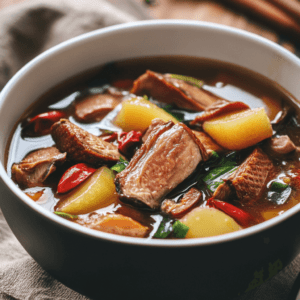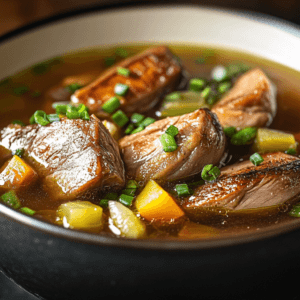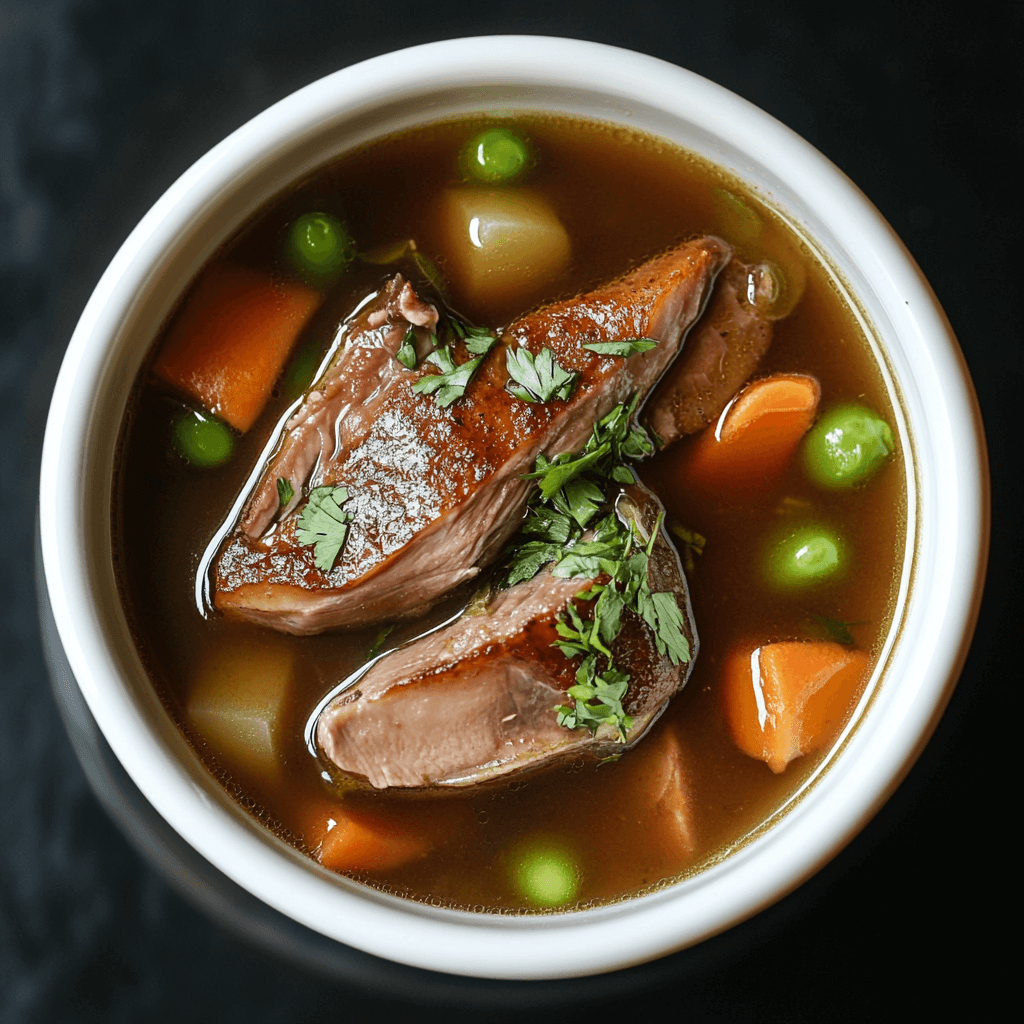Duck soup is a culinary masterpiece that has graced tables across the globe. Known for its rich flavors and hearty ingredients, it’s the perfect dish for a cold winter evening or a family gathering. In this guide, we’ll walk you through every step of making an impeccable duck soup recipe—from selecting the best ingredients to mastering the cooking techniques.
Introduction to Duck Soup Recipe
What is Duck Soup?
Duck soup is a hearty and savory broth-based dish that features duck as its primary protein, creating a rich and flavorful culinary experience. Known for its depth of taste and aromatic essence, duck soup is enjoyed in a variety of cultures and cuisines around the world, including Chinese, French, and Southeast Asian cooking traditions. Each regional variation brings its own unique ingredients and preparation techniques, from the use of aromatic herbs and spices in Southeast Asia to the delicate balance of flavors in French duck soups. The richness of the duck meat, combined with the infusion of herbs, vegetables, and spices, creates a deliciously comforting dish that is perfect for any season. Whether served as a main course or as part of a festive celebration, duck soup remains a beloved and versatile dish that showcases the distinct flavors of the duck, making it a must-try for food enthusiasts.
History and Cultural Relevance of Duck Soup

The origins of duck soup trace back centuries, with its rich history spanning across multiple cultures and regions. In Asia, particularly in China, duck soup is not only a delicious dish but also a symbol of prosperity, longevity, and health. It is often served during important festivals, family gatherings, and special occasions to bring good fortune and well-being. The preparation of duck soup in Asian cuisine involves a delicate balance of spices, herbs, and sometimes medicinal ingredients, creating a dish that is both flavorful and beneficial.
In contrast, French duck soup, particularly duck consommé, is known for its sophistication and elegance. This refined dish is often served at formal dinners and special gatherings, showcasing the skill and artistry of French cuisine. French duck consommé is typically prepared with a clear, rich broth, meticulously clarified to achieve a smooth and refined texture. It is a dish that exemplifies culinary craftsmanship and is often associated with luxury and fine dining. Duck soup, in both its Asian and French forms, has evolved to become a cherished part of the global culinary landscape, admired for its depth of flavor and cultural significance.
Why Duck Soup is a Nutritional Powerhouse
Duck soup is not only a delicious dish but also a nutritious one, offering a combination of protein, vitamins, and minerals that make it a wholesome choice for any meal. The rich, collagen-filled broth of duck soup provides numerous health benefits, particularly for skin and joint health. Collagen, a key component in the broth, is known to promote skin elasticity, reduce wrinkles, and support the overall health of connective tissues and joints. This makes duck soup an excellent option for those looking to improve their skin’s appearance or maintain joint flexibility.
Additionally, the duck meat itself is a great source of iron, a vital nutrient that supports the production of red blood cells and helps prevent anemia. Duck is also rich in essential vitamins, including B vitamins, which are crucial for energy metabolism and maintaining a healthy nervous system. With its combination of rich, flavorful broth and nutrient-packed meat, duck soup serves as a nourishing and satisfying meal that supports overall health and wellness. Whether consumed as a comforting dish or a health-boosting option, duck soup offers both taste and nourishment in every bowl.
Ingredients for Duck Soup Recipe
Choosing the Right Duck
When preparing duck soup, it’s important to choose a fresh or frozen whole duck for the best results. Opting for a whole duck allows you to make the most of the rich, flavorful meat and the collagen-packed broth, which are essential for a delicious and nutritious soup. For the highest quality, consider selecting free-range or organic ducks. These options typically provide superior flavor, as the ducks are raised in more natural environments with access to a varied diet. The result is a richer, more authentic taste that elevates your duck soup, making it even more satisfying and enjoyable. Whether you choose fresh or frozen, the quality of the duck you select will have a significant impact on the overall flavor and texture of your dish.
Essential Herbs and Spices
Key seasonings that are essential for creating a flavorful duck soup include garlic, ginger, star anise, and bay leaves. Each of these ingredients plays a crucial role in enhancing the soup’s overall complexity and depth of flavor. Garlic adds a robust, aromatic foundation, while ginger brings a hint of warmth and spice that perfectly complements the richness of the duck. Star anise contributes a sweet, licorice-like flavor that infuses the broth with a unique, exotic essence. Bay leaves, on the other hand, add subtle herbal notes that round out the flavor profile. Together, these seasonings elevate the soup, creating a harmonious balance of savory, aromatic, and slightly sweet flavors that make the dish truly memorable. Whether you’re making a traditional Asian-style duck soup or a French-inspired version, these key seasonings are essential to achieving the perfect balance of tastes in your bowl.
Optional Add-ins for a Unique Twist
To further customize your duck soup and tailor it to your taste, consider adding ingredients like mushrooms, bok choy, or chili peppers. Mushrooms, such as shiitake or oyster mushrooms, contribute a savory umami flavor and a rich, earthy texture that complements the duck perfectly. Bok choy, a mild yet crisp leafy green, adds freshness and a slight crunch to the soup, enhancing its overall balance. For those who enjoy a bit of heat, chili peppers can be incorporated to add a spicy kick and a vibrant layer of flavor. These additional ingredients not only elevate the taste but also provide a variety of textures and nutrients, making your duck soup even more delicious and satisfying. Feel free to experiment with other vegetables or seasonings to create a personalized version of this classic dish that suits your preferences.
Preparation Steps
Cleaning and Prepping the Duck
Begin by thoroughly cleaning the duck under running cold water. Make sure to remove any remaining feathers or debris. Once clean, use a sharp knife to trim off any excess fat from the duck, as this can affect the flavor of the broth. Afterward, pat the duck dry with paper towels to remove any moisture. Drying the duck ensures that it will sear properly if you’re browning it before adding it to the soup, helping to lock in flavor and achieve a rich, golden skin. This preparation step is key to making a flavorful and well-textured duck soup.
Prepping the Vegetables
Start by dicing carrots, celery, and onions to create a classic mirepoix, a foundational flavor base for your duck soup. The combination of these aromatic vegetables provides a subtle sweetness and depth that enhances the overall taste of the broth. For added nutrition and freshness, chop some leafy greens like spinach, kale, or bok choy. These greens not only bring extra vitamins and minerals but also contribute a vibrant color and texture to the soup. Together, the mirepoix and fresh greens help to create a well-rounded, nutrient-packed duck soup that’s both delicious and healthy.
Making the Base Stock
To create a rich, flavorful stock for your duck soup, begin by simmering duck bones in a large pot of water. Add aromatics such as ginger, garlic, and other seasonings like onions, star anise, and bay leaves. These ingredients will infuse the broth with deep, aromatic flavors. Allow the bones to simmer gently for several hours, skimming off any impurities or foam that rise to the surface. This slow simmering process helps extract the full richness of the duck, creating a savory, comforting stock that forms the base of your soup. The longer you let the stock cook, the more flavorful it will become, ensuring that your duck soup is both hearty and delicious.
Cooking Techniques for Duck Soup Recipe
Slow Cooking Method
Using a slow cooker is an excellent way to ensure tender meat and a well-infused broth for your duck soup. Place the duck, bones, and aromatics like ginger, garlic, and vegetables into the slow cooker, and cover with water. Set the slow cooker to cook on low for 6 to 8 hours. This slow cooking method allows the flavors to develop gradually, resulting in a rich, flavorful broth while keeping the duck meat tender and succulent. The long, gentle simmer also helps to extract the full essence of the duck, making your soup more delicious and comforting. Once the cooking time is complete, you’ll have a perfectly balanced, aromatic duck soup ready to enjoy.
Pressure Cooking for Quick Results
If you’re short on time but still want a rich, flavorful duck soup, a pressure cooker is a great option. Using a pressure cooker significantly speeds up the process, delivering the same depth of flavor as slow cooking in under an hour. Simply add the duck, bones, aromatics like ginger, garlic, and vegetables, and cover with water. Seal the pressure cooker and cook on high pressure for about 45 minutes to an hour. The high-pressure cooking method extracts the maximum flavor from the ingredients in a fraction of the time, resulting in a tender, savory duck soup that’s ready to serve much faster than traditional slow cooking.
Traditional Stove-Top Technique
This method allows for better control over flavor adjustments during the cooking process. After adding your duck, bones, aromatics like ginger and garlic, and vegetables to the pot, simmer gently for 2 to 3 hours. This slower cooking time gives you the opportunity to taste and adjust the seasonings as needed, ensuring that the flavors are perfectly balanced. You can add more salt, spices, or herbs as the broth develops, allowing for a more personalized and refined duck soup. The gentle simmering ensures the meat becomes tender while the broth absorbs the full richness of the ingredients, resulting in a flavorful and satisfying dish.
Flavor Enhancements for Duck Soup
Using Aromatic Ingredients
To brighten the flavors of your duck soup, add fresh herbs like cilantro or parsley just before serving. These herbs bring a burst of freshness and a vibrant color that enhances the overall taste of the dish. Simply chop the herbs finely and sprinkle them over the soup right before serving. The addition of fresh cilantro or parsley adds a refreshing contrast to the rich, savory broth, giving your soup a light, aromatic finish that balances the deeper flavors of the duck and seasonings. This final touch elevates the dish, making it even more flavorful and visually appealing.
How to Layer Flavors for Depth
To enhance the aroma and depth of your duck soup, toast spices like star anise or cinnamon before adding them to the pot. Simply heat a dry pan over medium heat and add the whole spices, stirring occasionally for about 1–2 minutes, until they become fragrant. Toasting the spices helps release their essential oils, intensifying their flavors and making your broth more aromatic. Once toasted, add the spices to the soup as it simmers, allowing their rich flavors to infuse the broth. This simple step adds an extra layer of complexity and warmth to your duck soup, elevating the overall taste.
Adjusting Salt and Acidity
To achieve a well-rounded taste in your duck soup, balance the saltiness with a splash of lemon juice or vinegar. The acidity from either ingredient helps brighten the flavors and cuts through the richness of the duck, creating a more harmonious and refreshing dish. Add the lemon juice or vinegar just before serving, tasting as you go to ensure the right balance. This final touch enhances the depth of the soup, offering a perfect contrast to the savory, rich broth, and leaving you with a more flavorful and satisfying meal.
Serving Suggestions
Pairing Duck Soup with Side Dishes
To make your duck soup a complete and satisfying meal, serve it with crusty bread, rice, or noodles. Crusty bread is perfect for dipping into the flavorful broth, adding texture and helping to soak up the savory liquid. If you prefer something heartier, rice is a great option, offering a mild base that complements the rich flavors of the soup. Alternatively, noodles add a comforting element, making the soup more filling and offering a pleasant texture to pair with the tender duck and aromatic broth. Whichever option you choose, these sides enhance the overall dining experience and turn your duck soup into a fulfilling meal.
Best Garnishes for Duck Soup
To add an extra layer of flavor and texture to your duck soup, top it with fried shallots, sliced scallions, or a drizzle of sesame oil. Fried shallots bring a crispy, slightly sweet crunch that contrasts beautifully with the rich broth and tender duck. Scallions, when finely sliced, add a fresh, mild onion flavor that brightens the dish. A drizzle of sesame oil adds a nutty, aromatic finish, enhancing the overall complexity of the soup. These simple garnishes elevate the soup, giving it a more vibrant and delicious flavor profile, making it even more enjoyable to eat.
Serving Tips for Special Occasions
Present your duck soup in elegant bowls with carefully arranged garnishes to truly impress your guests. The thoughtful presentation adds a touch of sophistication to the meal. Arrange the garnishes, such as fried shallots, sliced scallions, and a drizzle of sesame oil, neatly on top of the soup to create an aesthetically pleasing appearance. Using beautiful bowls that complement the rich color of the soup can also enhance the overall dining experience. This attention to detail not only elevates the visual appeal of the dish but also shows your guests the care and effort you’ve put into creating a memorable meal.
Health Benefits of Duck Soup
High Protein Content
Present your duck soup in elegant bowls with carefully arranged garnishes to truly impress your guests. The thoughtful presentation adds a touch of sophistication to the meal. Arrange the garnishes, such as fried shallots, sliced scallions, and a drizzle of sesame oil, neatly on top of the soup to create an aesthetically pleasing appearance. Using beautiful bowls that complement the rich color of the soup can also enhance the overall dining experience. This attention to detail not only elevates the visual appeal of the dish but also shows your guests the care and effort you’ve put into creating a memorable meal.
Rich in Vitamins and Minerals
Duck soup is loaded with essential nutrients like zinc, iron, and B vitamins, all of which support overall health. Zinc plays a key role in boosting the immune system and promoting healthy cell function. Iron is crucial for red blood cell production and helps prevent anemia by improving oxygen circulation throughout the body. B vitamins, including B6 and B12, support energy metabolism, brain function, and the health of your nervous system. With these vital nutrients, duck soup not only satisfies your taste buds but also contributes to your well-being, making it a nourishing and health-boosting meal choice.
Benefits of Slow-Cooked Broths
Slow cooking the duck allows the collagen from the bones to be released into the broth, which offers several health benefits. Collagen is known to improve skin elasticity, helping to maintain a youthful appearance and reduce the appearance of wrinkles. It also supports joint health by strengthening the cartilage and improving joint flexibility. As the duck simmers, the collagen breaks down, creating a rich, nutrient-dense broth that not only enhances the flavor of the soup but also provides these beneficial effects, making it a wholesome and rejuvenating meal.

FAQs About Duck Soup Recipe
- How long does it take to cook duck soup? Typically, it takes 2–8 hours depending on the cooking method.
- Can I use chicken instead of duck? Yes, but the flavor profile will differ significantly.
- What are the best substitutes for duck fat? Chicken fat or vegetable oil works well as alternatives.
- Can duck soup be made vegetarian? You can use plant-based broth and omit the duck for a vegetarian version.
- How do I reduce the gaminess of duck? Marinate the duck in citrus or vinegar to mellow its flavor.
- Is duck soup safe for pregnant women? Yes, as long as the duck is fully cooked and hygiene is maintained.
Conclusion and Final Thoughts
Duck soup is more than just a meal—it’s an experience. By following this guide, you’ll not only master the recipe but also appreciate its cultural and nutritional significance. Experiment with different ingredients to make it truly your own!
Did you like this duck soup recipe? Don’t miss the recipe for How to Make The Ultimate Meatloaf Recipe Lipton Onion Soup

